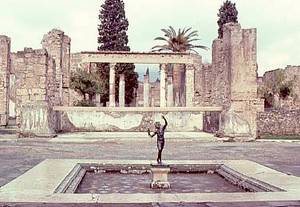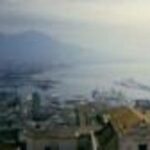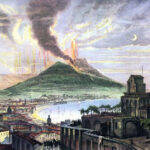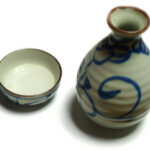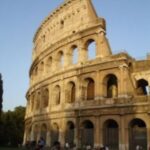In 79 AD, when the Roman Empire was just barely over a century old, Mount Vesuvius erupted and buried with it forever the great city of Pompeii. Fortunately for history’s sake, Gaius Plinius Caecilius Secundus, better known as Pliny the Younger, was there to witness the eruption firsthand and describe it in a letter to his friend, the historian Tacitus.
The town of Pompeii had long had its share of tremors, including a major earthquake in 62 AD, which is thought to have measured 7.5 on the Richter scale, as evidenced by the great damage done to the city and around the bay. Rebuilding was still being done at the time of Mount Vesuvius’s eruption. Unfortunately for the citizens of Pompeii and those towns nearby, the Romans were entirely ignorant of the link between seismic activity and volcanic activity. This is indicated by Pliny the Younger’s accounts of the eruption of Pompeii where his uncle, Pliny the Elder, are concerned.
Pliny the Elder was in command of the imperial naval base at Misenum, on the northwest side of the Bay of Naples. He was the senior military officer in the district, and knew more about natural science than most Romans living at the time. His 37-volume “Natural History,” in fact, is the longest work on natural history in Latin that has survived to this day.
But despite Pliny the Elder’s excessive knowledge in the field of natural science, he was clearly unfazed by the eruption of Mount Vesuvius. Pliny the Younger wrote later that his uncle was relaxing at the time of the eruption after having just taken a bath and finished a delicious lunch.
Upon taking notice of smoke rising over the Bay, Pliny the Elder was more curious than anything else. He and the citizens of Pompeii had clearly not anticipated this volcanic eruption. Coincidentally, just a few years prior to this eruption, the emperor Nero’s adviser Seneca wrote a discussion of the scientific causes of earthquakes. He concluded that it was very likely that earthquakes around the world were all interconnected in some way, but while linking it to stormy weather, failed to make the connection with volcanic activity.
Pliny the Elder decided to try and weather out the eruption of Mount Vesuvius. He was not alone in this; many others in the town felt that the wait it out approach was for the best, and lost their lives in the process. But an equal number of people felt that they must flee, and flee immediately. They were right to do so, especially after one reads Pliny the Younger’s account of the eruption: “A fearful black cloud by forked and quivering bursts flame, and parted to reveal great tongues of fire. Darkness fell, not the dark of a cloudy or moonless night, but as if the lamps had been put out in a dark room.”
The eruption continued for more than 24 hours, and those who fled at once were the ones who were most likely to survive. The volcanic debris was initially ash and pumice mixed with lithics, and was not completely lethal at that point. After midnight, however, everything changed. It was then that the first pyroclastic surges and flows occurred. The hot ash, pumice, rock fragments and volcanic gas sped down the side of Mount Vesuvius as fast as 100 kilometers an hour and spelled death for those trapped in Pompeii. The remains of fleeing victims were found alongside their possessions, which helped to better identify those who had died. Doctors were found with surgical tools, slaves were found with iron rings still around their ankles, and women were found clutching tightly to jewelry and household items.
Hundreds of refugees hid in vaulted arcades at the seaside and died from the intense heat of the first surge. The numerous surges that continued to rain down upon Pompeii asphyxiated those who were still fleeing or hiding inside their homes. But it wasn’t just Pompeii that was assaulted by Mount Vesuvius.
Just nine miles north of Pompeii lay the town of Herculaneum, a seaside resort for the Roman elite, and home to 5,000 residents. Many of Rome’s wealthiest citizens resided here in homes that overlooked the ocean. One of the most expensive and elaborate homes was found here — the Villa of the Papyri. The Villa of the Papyri was owned by Julius Caesar’s father-in-law Lucius Caesoninus and was excavated between 1750 and 1765. It had been buried beneath 30 meters of volcanic ash.
This particular villa boasted not only an astounding view of the Bay of Naples and a swimming pool, but also contained 1,758 papyrus scrolls which included texts from the Epicurean philosopher Philodemus as well as many Latin texts also.
Oplontis, a small town 3 miles from Pompeii, was also obliterated from Mount Vesuvius’s blasts.
The Romans, long accustomed to losing tens of thousands of people in battle, considered this catastrophe to be particularly phenomenal, which attests to just how many lives were lost in Pompeii and the towns that surrounded it.
Sources: BBC, Wikipedia, fieldmuseum.org
